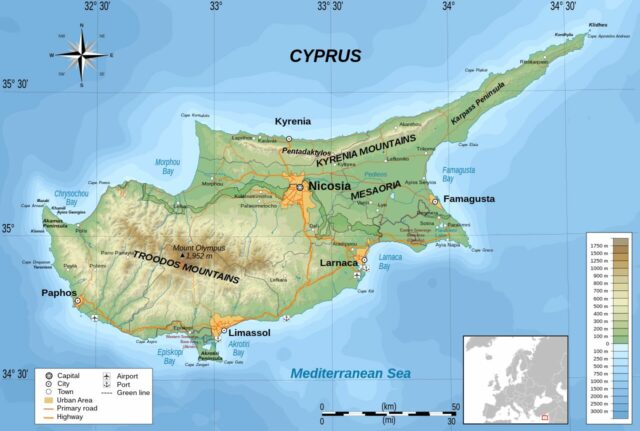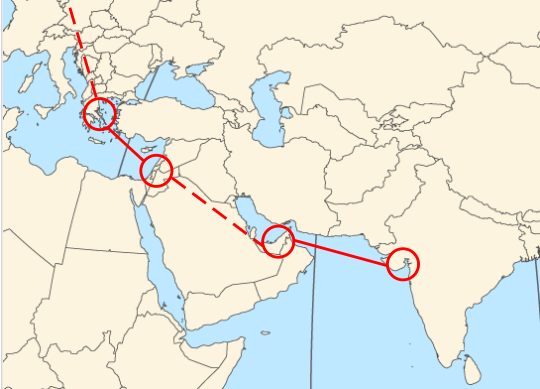
Geopolitical Report ISSN 2785-2598 Volume 39 Issue 3
SpecialEurasia OSINT Team
The India-Middle East-Europe Economic Corridor (IMEEEC) emerges as a promising pathway for economic prosperity in Cyprus, bearing implications that transcend geographical boundaries. IMEEEC confirms that the island’s strategic significance lies in its geographical location in the Eastern Mediterranean Sea, serving as a crucial hub linking Europe, Asia, and Africa.
Different world leaders (regional and international key players) promoted this initiative to fortify economic ties across Asia, the Persian Gulf, and Europe, considering also that IMEEEC offers a different pathway compared to Beijing’s Belt and Road Initiative.
The IMEEEC economic corridor, covering approximately 4800 kilometres, aims to not only reduce transportation costs and accelerate trade, but also enhance global economic connectivity.
However, uncertainties surrounding project timelines, financing, and geopolitical challenges, notably the conflict in Gaza, cast shadows on the envisioned benefits.
This report aims to investigating how the IMEEEC might positively affect Cyprus’ economy and, simultaneously, assess which risks might threaten the positive outcome of the economic corridor.
Background Information
In a report published on January 22nd, 2024, Andreas Poullikkas, Chairman of the Cyprus Energy Regulatory Authority (CERA), analysed Cyprus’ role in the IMEEEC and opportunities and challenges for the Mediterranean island and the economic corridor, especially considering the current geopolitical dynamics in the Middle East and the international arena.
The India-Middle East-Europe Economic Corridor (IMEEEC) is a proposed trade and transit corridor designed to improve connectivity and foster economic cooperation among India, the Middle East, and Europe. Stakeholders envision this corridor as a route strategically used for the movement of goods, services, and people, with the potential to impact regional and global trade dynamics significantly.
Saudi Arabia, the European Union, India, the United Arab Emirates (UAE), France, Germany, Italy, and the United States promoted the IMEEEC to fortify economic ties across Asia, the Persian Gulf, and Europe.
The IMEEEC initiative comprises two critical components – the Eastern Corridor, which links the Arabian Gulf with India, and the Northern Corridor, which connects the Arabian Gulf with Europe. This integration of rail networks, maritime transport, and other modes will interconnect renowned ports such as Fujairah, Jebel Ali, Abu Dhabi, Haifa, Mundra, Kandla, Piraeus, Marseille, and Messina.
The signatories’ countries of the IMEEEC corridor represent a substantial 40% of the world’s population and over 50% of the global economy. The potential economic benefits extend beyond Cyprus, offering regionally and internationally significant advantages.
The IMEEC bears strategic importance, as it has the potential to establish alternative trade routes that circumvent conventional chokepoints, such as the Suez Canal. By providing an alternative pathway for trade between India, the Middle East, and Europe, the corridor could reduce dependency on existing maritime routes and mitigate geopolitical risks associated with concentrated shipping lanes. Furthermore, the IMEEC possesses the capability to augment regional cooperation and fortify diplomatic relations among the participating nations.
Considering its geographical position in the Mediterranean Sea, the IMEEEC aligns with Cyprus’s potential to become a hub for trade efficiency, contributing to regional economic connectivity and fostering job opportunities. The potential reduction in transportation costs by 30% to 40%and a 40% faster trade between India and Europe could reshape economic dynamics for Cyprus.
However, inherent uncertainties in project timelines, financing, and geopolitical challenges, especially the conflict in Gaza, present tangible risks to Cyprus’s sustained involvement and success in the initiative.
The logistic corridor and transport corridor have the potential to boost Cyprus’s economic development. As part of the IMEEEC initiative, Cyprus can leverage its renewable energy projects, aligning with global trends towards sustainability. Indeed, the exploration of energy exports, including natural gas, electricity, or hydrogen, aligns with Cyprus’s vision for a diversified and sustainable energy portfolio.
Read more | From Airstrikes to Ground Operations: Navigating the Israel-Hamas Escalation and Risk Scenarios |
Geopolitics of Cyprus:
An Overview of a Divided Island in the Mediterranean Sea
Cyprus, situated in the Eastern Mediterranean, presents a complex geopolitical landscape intricately intertwined with its historical narrative, regional dynamics, and international involvements. Its strategic geographical placement makes it a nexus of divergent geopolitical interests and historical conflicts, creating a complex terrain for strategic manoeuvring.
The understanding of Cyprus’ current geopolitical complexities necessitates an examination of its historical background, which reveals a multitude of foreign influences. From Greek and Roman dominion to Byzantine and Ottoman rule, the island’s historical tapestry is testament to its resilience amidst geopolitical vicissitudes.
Gaining independence from British colonial rule in 1960, Cyprus found itself at the crossroads of complexity because of its ethnic composition, housing Greek Cypriots and Turkish Cypriots, a milieu that ignited both internal strife and external interventions.
The division of Cyprus into the Greek Cypriot-controlled south and the Turkish Cypriot-controlled north begets seismic geopolitical ramifications. In the aftermath of the 1974 military intervention by Turkey, which was prompted by intercommunal violence and a coup attempt seeking annexation to Greece, the island was divided into the Turkish Republic of Northern Cyprus, which lacks international recognition. This division, etched in geopolitical contours, continues to cast a long shadow, shaping the geopolitical dynamics of the region.
Given the regional energy discoveries and maritime disputes, the geopolitical importance of Cyprus in the Eastern Mediterranean becomes of utmost significance.
The revelation of substantial natural gas reserves in its waters amplifies tensions, entangling Cyprus, Greece, Turkey, and other regional players in a web of territorial disputes and power dynamics.
Risk Assessment
The conflict in Gaza emerges as a primary threat to the IMEEEC, causing delays and straining diplomatic relations between key players. Saudi Arabia’s recent stance on Israel further complicates matters. Indeed, on February 7th, 2024, in a meeting with US Secretary State, Anthony Blinken, the Saudi foreign affairs ministry communicated Riyadh will not open diplomatic relations with Tel Aviv unless the recognition of an independent Palestinian state on 1967 borders with Jerusalem as its capital.
Additionally, the potential inadvertent bolstering of Russia’s influence and uncertainties in project timelines and financing raise apprehensions about the corridor’s feasibility. Cyprus must navigate these challenges with prudence, considering both economic opportunities and geopolitical ramifications.

Scenarios Analysis
- Optimistic Scenario. Successful resolution of the conflict in Gaza, diplomatic breakthroughs, and timely project implementation lead to the IMEEEC realising its full potential, boosting Cyprus’s economic development and global standing.
- Moderate Scenario. Diplomatic challenges persist, causing some delays and uncertainties in project implementation. However, collaborative efforts mitigate risks, and the IMEEEC contributes significantly to regional connectivity and economic development.
- Pessimistic Scenario. Escalation of the conflict in Gaza, sustained geopolitical challenges, and difficulties in project implementation result in the IMEEEC falling short of expectations. Cyprus faces economic setbacks, and the corridor cannot achieve its intended transformative impact.
Read more | Increasing Geopolitical Risk in the Middle East |
Conclusion/Recommendations
With its immense potential, the IMEEEC has the power to reshape Cyprus’ economic landscape and enhance its geopolitical influence worldwide.
Nevertheless, the shadow of uncertainties looms large, casting doubts on the envisioned benefits of the IMEEEC. The ongoing conflict in Gaza, coupled with concerns about project timelines, financing, and potential geopolitical challenges, poses tangible risks to Cyprus’s sustained involvement and success in this transformative initiative.
Cyprus’s role in the IMEEEC is both an opportunity and a challenge, demanding a delicate balance between economic aspirations and geopolitical complexities.
The division of Cyprus into the Greek Cypriot-controlled south and the Turkish Cypriot-controlled north, compounded by regional energy discoveries and maritime disputes, adds layers of complexity to the geopolitical landscape.
The exploration of energy exports, aligned with global sustainability trends, provides an avenue for Cyprus to leverage its renewable energy projects within the IMEEEC, potentially contributing to a diversified and sustainable energy portfolio.
Faced with these challenges and opportunities, Cyprus must tread judiciously, strategically navigating the intricate geopolitical dynamics. The scenarios analysis, ranging from optimistic breakthroughs to pessimistic setbacks, underscores the need for agile and adaptive decision-making.
For those with an interest in acquiring comprehensive insights into the geopolitical dynamics of the Mediterranean Sea and Cyprus, we encourage you to reach out to SpecialEurasia by emailing info@specialeurasia.com. We are ready to assist you in evaluating the possibility of acquiring a carefully crafted and customised report to meet your intelligence requirements.
